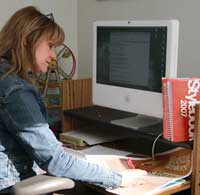How
Shall I Put it?

Eileen Dunn, communications editor, refines a sample
of copy |
You’re in your office at Smith working hard on writing
an important report or text for a printed brochure. You come
to a standstill when a clause or a particular word usage
doesn’t seem to make sense. Time is tight and stress
is building. You need to know the best way to express what
you have to say.
Thanks to the work of
Eileen Dunn, communications editor in college relations,
there’s a place to go for answers.
The , which was recently
updated by Dunn, is an online compendium of preferred usages
and campus references arranged in alphabetical order.
The resource, which is regularly maintained by Dunn, provides
general rules on how to refer to academic degrees, disciplines
and titles, for example, or to departments and people on
campus.
“If writers have questions, they should check the
style guide first,” says Dunn.
The style guide is based on the Associated Press Stylebook,
and that is the next recommended source for writers on campus,
says Dunn. The Chicago Manual of Style (considered
the “bible” by many copy editors) can also be
used for more technical questions or for those requiring
more detailed explanations.
Unlike other style guides, the
Smith resource provides specific college references and preferred
usages within the Smith writing community. It also addresses
some of the more common questions encountered in academic
writing. Do you sometimes wonder whether to write
email (without a hyphen) or e-mail? How should you refer
to S.O.S.? Should the Gamut be capitalized? Is it correct
to abbreviate academic degrees in text?
The has answers.
By adhering to the college’s
style guide, Dunn emphasizes, online and printed materials
across campus will be more uniform and cohesive.
“We want to maintain consistency in the written materials
produced on campus,” says Dunn. “This guide represents
the style that we would prefer campus writers to follow.”
However, Dunn points out,
the guide is not intended as a panacea for all grammatical
issues. “A style guide
isn’t really an imperative,” she says, “it’s
more a set of guidelines.”
Dunn, who joined the Smith
staff in 2000, periodically updates the college’s style guide. Listings are added or altered
to reflect changes on campus or changes in the language as
it evolves and becomes more inclusive. Recent changes have
included department names, such as the Program for the Study
of Women and Gender, which was formerly women’s studies,
and the Department of Religion, formerly the Department of
Religion and Biblical Studies. Recent building names have
also been added, such as the Campus Center (capitalized)
and Ford Hall, the new building for the sciences and engineering.
Further, the new version of the style sheet features many
linked cross-references for easy navigation to other topics
and is available in PDF format for a high-quality print-out
option.
Even with the new edition of the Smith College Style
Guide, writing questions will no doubt arise. If,
after checking the guide, campus writers still feel “stuck,” Dunn
encourages them to contact her.
“I like phone calls or e-mail messages,” she
assures. “Editing can be very isolated work, and I
welcome any human contact.”
Dunn can be reached at ext. 2182 or via e-mail (preferred
Smith style, according to the guide) at edunn@email.smith.edu.
|























